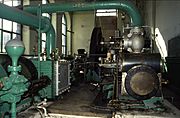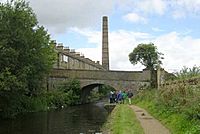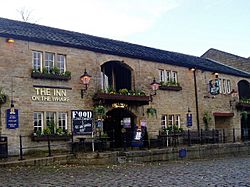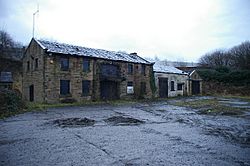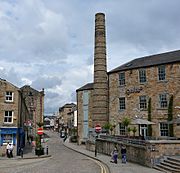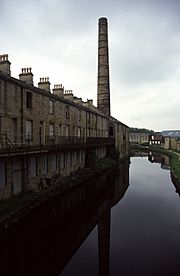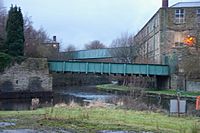Weavers' Triangle facts for kids
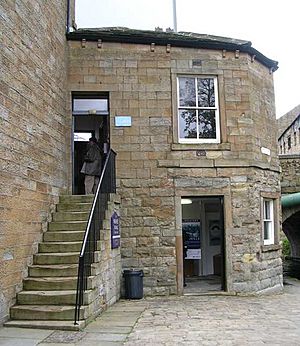 |
|
| Lua error in Module:Location_map at line 420: attempt to index field 'wikibase' (a nil value). | |
| Established | 26 August 1980 |
|---|---|
| Location | 85 Manchester Rd, Burnley, Lancashire, England |
| Type | Historic textile-producing area with a cotton museum |
The Weavers' Triangle is a special part of Burnley in Lancashire, England. It's full of old factory buildings from the 1800s, located near the Leeds and Liverpool Canal. This area is very important because its cotton mills and other buildings show how the town and its weaving industry grew. Since the 1980s, people have worked hard to fix up and reuse these historic buildings.
Contents
A Look Back: History of the Weavers' Triangle
Burnley was once known for making wool in the 1700s. But in the early 1800s, it started focusing on cotton. New machines like the spinning jenny (invented in 1767) helped make thread. Later, the power-driven water frame made even stronger thread.
The Canal and Steam Power
The Leeds and Liverpool Canal was a big deal for Burnley. Its construction started again in the 1790s. The canal's path was changed to go through the Burnley Coalfield, which was important for getting coal. This coal was used to power new steam engines in textile factories. The canal made it easier to bring in cotton and send out finished cloth.
In the 1840s, things really changed. Mills could take water directly from the canal for their steam engines. Railways also arrived, making it even easier to transport goods. This led to many new cotton mills being built along the canal, especially in the area that became the Weavers' Triangle.
Burnley's Cotton Boom
In the second half of the 1800s, Burnley became the most important cotton-weaving town in the world. By 1911, the town had about 99,000 power looms working! The town's population grew from 4,000 in 1801 to over 100,000 people.
After World War II, the English cotton industry faced tough times. Many mills were torn down. However, most of the buildings in the Weavers' Triangle were saved. Today, they stand as reminders of Burnley's rich industrial past.
Amazing Buildings: Architecture of the Weavers' Triangle
The Weavers' Triangle is special because so many 19th-century buildings are close together. Each type of building played a key role in the cotton industry.
Canal Warehouses
Along the canal, you can see old warehouses. These buildings were used to store goods that arrived or left by canal boat. Some had special cranes to lift things directly from the barges.
Weaving Sheds
Weaving sheds were large, single-story buildings where cloth was made. They often had a special "sawtooth" roof with windows facing north. This design let in natural light without direct sunlight, which was better for the workers. Many stone-built weaving sheds, like the Waterloo Shed, are still there.
Spinning Mills
Spinning mills were taller buildings, often two or three stories high. This is where raw cotton was spun into yarn. Victoria Mill is an example of an early spinning mill.
Combined Mills
Some mills, called combined mills, did both spinning and weaving. They would spin the yarn and then use it in their own weaving sheds. Trafalgar Mill is a good example of a combined mill. These mills often added sprinkler systems in the 1880s to prevent fires.
Foundries
Burnley was also home to important engineering companies called foundries. These places made parts for the mills, including huge mill engines and looms (the machines that wove cloth).
Exploring the Past: The Visitor Centre
In 1977, a group was formed to help save Burnley's history. The Weavers' Triangle Toll House museum opened on August 26, 1980. It started in two rooms but grew into the Weavers' Triangle Visitor Centre.
The centre is run by volunteers. In 1993, they took over the engine house at Oak Mount Mill. A big project began in 1996 to fix the steam engine there. It was finished in 2001. Now, an electric motor powers the engine, as replacing the original boiler was too expensive. Both the engine and the building are now protected as historic sites.
Where It Is: Geography of the Weavers' Triangle
The Weavers' Triangle is on the southwestern edge of Burnley's town centre. It's next to the main shopping and cultural areas. The River Calder and River Brun flow through the town.
The Leeds and Liverpool Canal is like the backbone of the Weavers' Triangle. It was built in 1796 and gave Burnley a way to connect to Liverpool. This meant cotton from places like the Mississippi Basin and Egypt could easily arrive. Coal to power the steam engines also came by canal. The canal is much higher than the rivers in some places. It even crosses the river valleys on a long, high structure called the Burnley Embankment.
The historic part of the Weavers' Triangle is bordered by Manchester Road, Trafalgar Street, Westgate, and Queen's Lancashire Way. The Burnley Way, a walking path, goes through the area and along the canal towpath. You can also reach the area easily by train, with Manchester Road station and Barracks station nearby.
Bringing It Back to Life: Regeneration Efforts
Over the years, many efforts have been made to bring the Weavers' Triangle back to life.
1990s Improvements
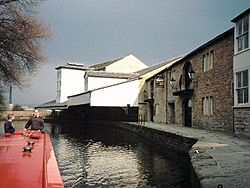
Between 1990 and 1996, Trafalgar Mill was extensively refurbished. This work included fixing the roof, cleaning the walls, and replacing windows. Parts of the building are now used by local businesses.
In the mid-1990s, Burnley wharf, where the visitor centre is located, was also restored. This project included adding a bar and restaurant in one of the old warehouses. There were also plans to turn Finsley Wharf into a marina and leisure complex.
Some buildings faced challenges. In 1999, a fire badly damaged Sandygate Mill. However, other projects, like restoring the former Proctors' Iron Works in Hammerton Street, were successful.
2000s and Beyond
In the early 2000s, some older mills like Clock Tower Mill and Globe Works had to be torn down because they were unsafe. However, new plans emerged to redevelop other sites for housing and businesses.
In 2006, a big plan was created to attract developers to the area. There were ideas for new homes, offices, and even a music venue. Unfortunately, the 2008 financial crisis caused many of these projects to be put on hold.
In 2008, a fire destroyed a large part of Woodfield Mill. Despite these setbacks, efforts continued. In 2009, repair work began on Victoria Mill and the historic Neptune Pub.
In July 2014, a new canal footbridge was put in place at the heart of the Weavers' Triangle. This bridge, called the Sandygate canal footbridge, helps people cross the Leeds and Liverpool Canal. It opened to the public in December 2014, making it easier for visitors to explore the area.


